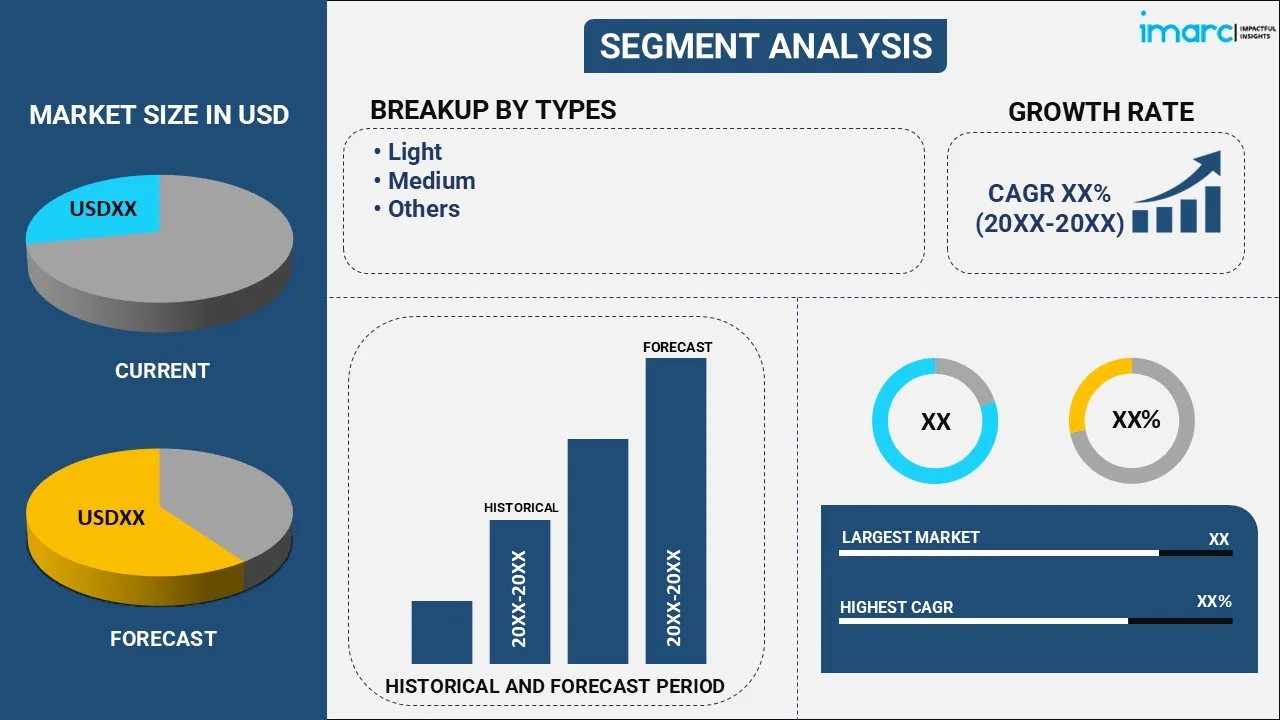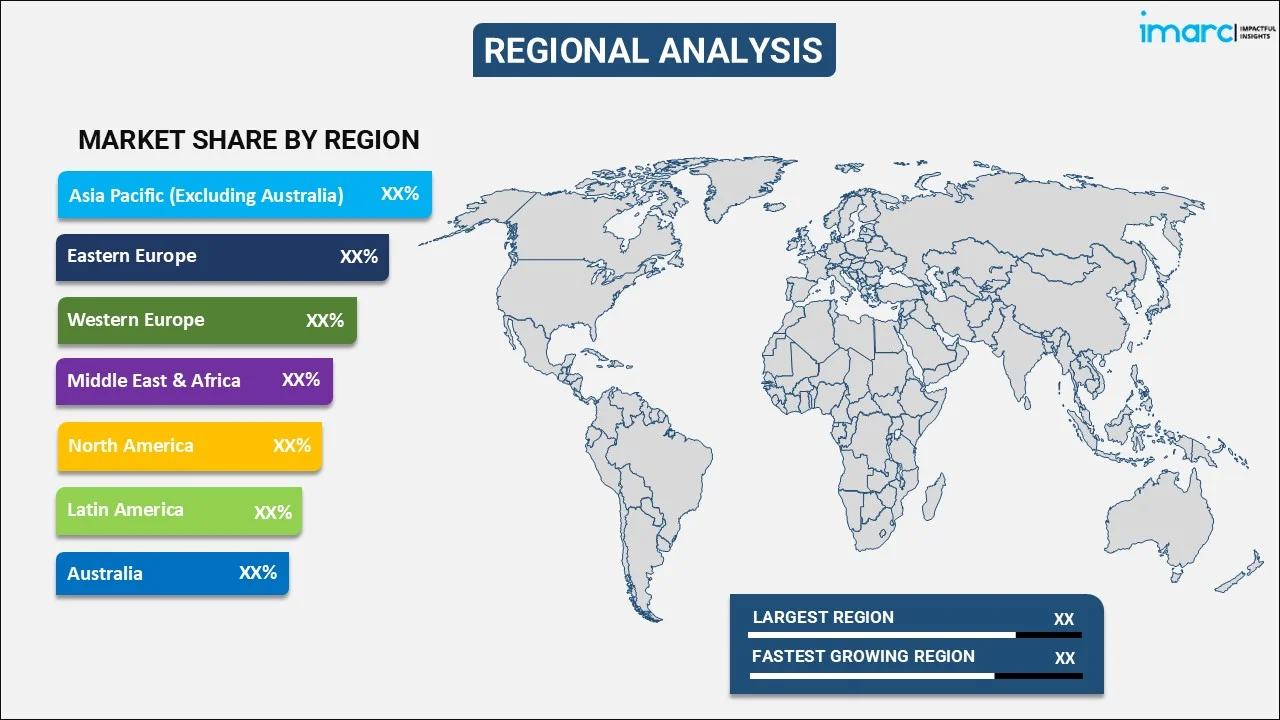
Cigarette Market Report by Type (Light, Medium, and Others), Distribution Channel (Tobacco Shops, Supermarkets and Hypermarkets, Convenience Stores, Online Stores, and Others), and Region 2025-2033
Market Overview:
The global cigarette market size reached USD 1,143.4 Billion in 2024. Looking forward, IMARC Group expects the market to reach USD 1,380.2 Billion by 2033, exhibiting a growth rate (CAGR) of 1.9% during 2025-2033. The increasing social and cultural influence, numerous effective marketing and advertising campaigns, and the introduction of several innovative cigarette products, such as e-cigarettes, or flavored cigarettes are some of the major factors propelling the market.
|
Report Attribute
|
Key Statistics
|
|---|---|
|
Base Year
|
2024
|
|
Forecast Years
|
2025-2033
|
|
Historical Years
|
2019-2024
|
|
Market Size in 2024
|
USD 1,143.4 Billion |
|
Market Forecast in 2033
|
USD 1,380.2 Billion |
| Market Growth Rate 2025-2033 | 1.9% |
Cigarette Market Analysis:
- Market Growth and Size: The global cigarette market is experiencing steady growth, driven by factors like the increasing smoking habits among the masses to overcome stress and anxiety.
- Major Market Drivers: Key drivers include deep-rooted cultural acceptance of smoking in certain societies and the introduction of value-added products, such as flavored cigarettes and slim variants.
- Key Market Trends: A notable trend in the cigarette market is the increasing shift towards alternative nicotine delivery systems, such as e-cigarettes and vaping products, driven by health consciousness and regulatory pressures.
- Geographical Trends: Geographical Trends: Asia Pacific (excluding Australis) dominates the market, driven by the prevalence of smoking culture and rising popularity of using vapes among young individuals. However, North America is emerging as a fast-growing market on account of the increasing smoking habits among the masses.
- Competitive Landscape: The market is characterized by a mix of established companies and innovative startups, with a focus on developing innovative tobacco formulations, strategic partnerships, and expanding product portfolios to gain a competitive edge.
- Challenges and Opportunities: Challenges include increasing government regulations, rising health awareness, and growing anti-smoking campaigns. Nonetheless, opportunities exist in the development and promotion of reduced-risk products and expansion into emerging markets with less stringent regulatory landscapes.

Cigarette Market Trends/Drivers:
The increasing social and cultural influences
The increasing social and cultural influences are shaping the dynamics of the market. In addition, smoking is often influenced by social norms, peer pressure, and cultural acceptance, particularly in societies where smoking is ingrained as a part of daily life or social interactions, thus influencing cigarette market growth. Also, smoking is considered a symbol of social status, sophistication, or camaraderie, leading to its integration into various social settings, gatherings, and rituals, thus offering a favorable cigarette market outlook. Peer influence and the desire to fit into social groups can also drive individuals, especially younger demographics, to take up smoking. Moreover, depictions of smoking in movies, television shows, and advertisements are encouraging smoking as desirable or glamorous, further representing another major growth-inducing factor. Besides this, the increasing advertisements of smoking by celebrities, influencers, and sports personalities are impacting perceptions, making it more appealing to impressionable audiences thus accelerating the market growth. Along with this, social media platforms and online communities are acting as catalysts in normalizing smoking behavior among certain groups, thus propelling market growth.
Several effective marketing and advertising campaigns
Tobacco companies are investing substantially in resources such as strategic marketing to create brand awareness, foster brand loyalty, and attract new smokers. Additionally, these campaigns often employ sophisticated advertising techniques that appeal to specific target audiences. They use imagery, slogans, and narratives that evoke emotions, aspirations, or lifestyle choices associated with smoking. For instance, advertisements may depict smoking as a symbol of freedom, sophistication, rebellion, or social acceptance, alluring potential smokers to associate positive attributes with their products. Moreover, strategic product placement in movies, television shows, and music videos helps embed smoking imagery in popular culture, reinforcing the notion that smoking is desirable and socially accepted. Besides this, tobacco companies often sponsor events, concerts, and sports competitions, using these platforms to promote their brands and products to wide-ranging audiences, including youth, thus accelerating market growth. Furthermore, companies are using social media platforms and online advertising to reach younger audiences via influencer marketing and sponsored content, subtly promoting smoking to impressionable viewers, creating a positive market outlook.
The introduction of innovative cigarette products
Tobacco companies are diversifying their product offerings, introducing various alternatives to traditional product. In addition, the introduction of flavored cigarettes, offering consumers numerous of taste options beyond traditional tobacco flavors is influencing the market growth. Also, flavored product appeal to younger demographics and individuals looking for unique and appealing smoking experiences, thus augmenting the market growth. Moreover, tobacco companies are exploring reduced-risk tobacco products, such as heat-not-burn devices and e-cigarettes that provide a potentially less harmful alternative to traditional combustible cigarettes, attracting smokers who are considering harm reduction or smoking cessation, representing another major growth-inducing factor. Besides this, it is gaining popularity for its convenience, portability, and absence of harmful tar and combustion by-products, thus accelerating market growth. Many smokers perceive it as a less harmful option and a potential aid in quitting smoking altogether. The cigarette market forecast indicates resilient growth, adapting to evolving consumer preferences and regulatory landscapes.
Cigarette Industry Segmentation:
IMARC Group provides an analysis of the key trends in each segment of the global cigarette market report, along with forecasts at the global and regional levels from 2025-2033. Our report has categorized the market based on type and distribution channel.
Breakup by Type:

- Light
- Medium
- Others
Light cigarettes represent the most popular types
The report has provided a detailed breakup and analysis of the market based on the type. This includes light, medium and others. According to the report, light cigarettes accounted for the largest market share.
Light cigarettes, also known as low-tar or low-nicotine cigarettes, are characterized by their reduced levels of tar, nicotine, and other harmful compounds compared to regular or full-flavor products. In addition, the perception among smokers is that they are less harmful and pose a lower health risk than regular product is influencing the market growth. Many smokers believe that by choosing light-type products, they can potentially mitigate the adverse health effects associated with smoking.
Moreover, light cigarettes are often marketed as a milder and smoother smoking experience, appealing to individuals who may find the taste and harshness of regular products less desirable which represents another major growth-inducing factor. Besides this, regulatory initiatives in some countries require cigarette manufacturers to label tar and nicotine content on product packs which led some consumers to opt for light products, believing that they are making a safer choice thus accelerating the market growth.
Breakup by Distribution Channel:
- Tobacco Shops
- Supermarkets and Hypermarkets
- Convenience Stores
- Online Stores
- Others
Cigarettes are widely distributed through tobacco shops
A detailed breakup and analysis of the market based on the distribution channel has also been provided in the report. This includes tobacco shops, supermarkets and hypermarkets, convenience stores, online stores, and others. According to the report, tobacco shops accounted for the largest cigarette market share.
Tobacco shops, also known as specialty tobacco retailers or tobacconists, are specialized shops focused on selling tobacco products, including cigarettes, cigars, pipe tobacco, and smoking accessories. Additionally, tobacco shops are establishing a strong presence in the market due to their expertise in tobacco products and the personalized service they offer to customers is influencing the market growth. Also, smokers often prefer purchasing products from these dedicated outlets as they can access numerous kinds of brands and tobacco blends, allowing them to find products that match their preferences.
Moreover, tobacco shops provide a unique shopping experience, offering knowledgeable staff who can assist customers in selecting suitable products and provide insights into different tobacco blends and smoking techniques. This personalized approach fosters customer loyalty and enhances the shopping experience for smokers. Additionally, tobacco shops may have exclusive deals with certain tobacco manufacturers, allowing them to offer limited edition or specialty products that may not be readily available in other retail channels.
Breakup by Region:

- Asia Pacific (Excluding Australia)
- Eastern Europe
- Western Europe
- Middle East and Africa
- North America
- Latin America
- Australia
Asia Pacific (excluding Australia) exhibits a clear dominance in the market
The report has also provided a comprehensive analysis of all the major regional markets, which include Asia Pacific (excluding Australia), Eastern Europe, Western Europe, the Middle East and Africa, North America, Latin America, and Australia. According to the report, Asia Pacific (excluding Australia) accounted for the largest market share.
Additionally, the growing population, rapid urbanization, diverse smoking culture, and the presence of significant tobacco-consuming countries are contributing to its prominence in the industry. Also, countries such as China, India, Indonesia, and Japan are among the largest consumers of cigarettes in the world. Along with this, the smoking prevalence in these nations is often influenced by cultural factors, social acceptance, and longstanding traditions associated with smoking. Moreover, the rising product demand among individuals across the region and several companies adapting their marketing efforts to align with local preferences and cultural norms, are further enhancing their market presence. The cigarette Market demand is robust, driven by entrenched smoking habits and the introduction of innovative product variations catering to diverse consumer preferences.
Besides this, North America market is witnessing a rising demand for reduced-risk tobacco products such as e-cigarettes and heat-not-burn devices, indicating a shift toward harm reduction and smoking cessation initiatives, thus representing another major growth-inducing factor. Furthermore, the increasing investment in product innovation and marketing efforts to retain its consumer base are accelerating the market growth.
Competitive Landscape:
Nowadays, key players in the market are employing various strategies to strengthen their position and maintain their competitive edge. They are diversifying their product portfolios to include numerous brands, flavors, and product variants to appeal to different consumer preferences. Moreover, companies are investing in innovative and eye-catching packaging designs to differentiate their brands and attract consumers at the point of sale. They are investing in the development and marketing of reduced-risk tobacco products, such as e-cigarettes and heat-not-burn devices, to cater to consumers seeking alternatives to traditional products. Furthermore, continuous research and development (R&D) efforts are dedicated to product innovation, including advancements in filter technology, tobacco blends, and smoking experience enhancements. They are actively expanding their market presence into emerging economies and high-potential regions to tap into new consumer markets and increase their sales volume. The cigarette market revenue continues to reflect significant profitability, underpinned by persistent global demand and strategic market expansions.
The report has provided a comprehensive analysis of the competitive landscape in the market. Detailed profiles of all major companies have also been provided. Some of the key players in the market include:
- China National Tobacco Corporation
- Phillip Morris International
- British America Tobacco
- Japan Tobacco International
- Imperial Tobacco Group
Recent Developments:
- In August 2021, Japan Tobacco International launched Ploom X, its next-generation heated tobacco sticks, that is available across Japan, including convenience stores and select tobacco retail stores.
- In May 2022, British America Tobacco (BAT) test-launched a new single-use, or disposable, e-cigarette called Vuse Go in the UK., that are available in nine flavours including mint ice, creamy tobacco, and multiple fruit flavors.
- In February 2021, Imperial Tobacco Group launched new crush embassy cigarettes designed specifically for ex-menthol crushball smokers, featuring a cooling sensation filter, promoting to be employed specifically with its menthol-flavored cardboard inserts.
Cigarette Market Report Scope:
| Report Features | Details |
|---|---|
| Base Year of the Analysis | 2024 |
| Historical Period | 2019-2024 |
| Forecast Period | 2025-2033 |
| Units | Million Sticks, Billion USD |
| Scope of the Report | Exploration of Historical and Forecast Trends, Industry Catalysts and Challenges, Segment-Wise Historical and Predictive Market Assessment:
|
| Types Covered | Light, Medium, Others |
| Distribution Channels Covered | Tobacco Shops, Supermarkets and Hypermarkets, Convenience Stores, Online Stores, Others |
| Regions Covered | Asia Pacific (Excluding Australia), Eastern Europe, Western Europe, Middle East and Africa, North America, Latin America, Australia |
| Companies Covered | China National Tobacco Corporation, Phillip Morris International, British America Tobacco, Japan Tobacco International, Imperial Tobacco Group, etc. |
| Customization Scope | 10% Free Customization |
| Post-Sale Analyst Support | 10-12 Weeks |
| Delivery Format | PDF and Excel through Email (We can also provide the editable version of the report in PPT/Word format on special request) |
Key Benefits for Stakeholders:
- IMARC’s report offers a comprehensive quantitative analysis of various market segments, historical and current market trends, market forecasts, and dynamics of the cigarette market from 2019-2033.
- The research study provides the latest information on the market drivers, challenges, and opportunities in the global cigarette market.
- The study maps the leading, as well as the fastest-growing, regional markets.
- Porter's five forces analysis assist stakeholders in assessing the impact of new entrants, competitive rivalry, supplier power, buyer power, and the threat of substitution. It helps stakeholders to analyze the level of competition within the cigarette industry and its attractiveness.
- Competitive landscape allows stakeholders to understand their competitive environment and provides an insight into the current positions of key players in the market.
Key Questions Answered in This Report
The global cigarette market was valued at USD 1,143.4 Billion in 2024.
We expect the global cigarette market to exhibit a CAGR of 1.9% during 2025-2033.
The increasing number of smokers, owing to the hectic work schedules and the growing peer influence towards early exposure to smoking, is primarily driving the global cigarette market.
The sudden outbreak of the COVID-19 pandemic had led to the implementation of stringent lockdown regulations across several nations resulting in temporary closure of numerous manufacturing units for cigarettes.
Based on the type, the global cigarette market has been segregated into light, medium, and others. Among these, light cigarettes currently hold the largest market share.
Based on the distribution channel, the global cigarette market can be bifurcated into tobacco shops, supermarkets and hypermarkets, convenience stores, online stores, and others. Currently, tobacco shops exhibit a clear dominance in the market.
On a regional level, the market has been classified into Asia Pacific (excluding Australia), Eastern Europe, Western Europe, Middle East and Africa, North America, Latin America, and Australia, where Asia Pacific (excluding Australia) currently dominates the global market.
Some of the major players in the global cigarette market include China National Tobacco Corporation, Phillip Morris International, British America Tobacco, Japan Tobacco International, and Imperial Tobacco Group.
Need more help?
- Speak to our experienced analysts for insights on the current market scenarios.
- Include additional segments and countries to customize the report as per your requirement.
- Gain an unparalleled competitive advantage in your domain by understanding how to utilize the report and positively impacting your operations and revenue.
- For further assistance, please connect with our analysts.
 Inquire Before Buying
Inquire Before Buying
 Speak to an Analyst
Speak to an Analyst
 Request Brochure
Request Brochure
 Request Customization
Request Customization




.webp)




.webp)












